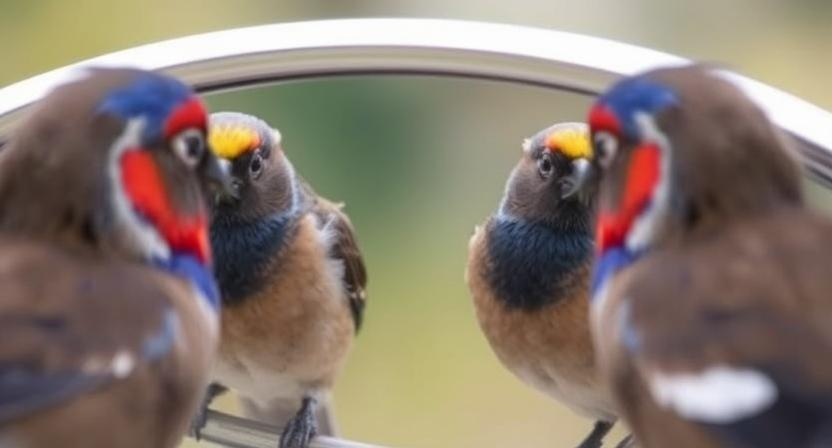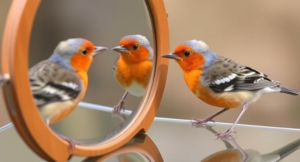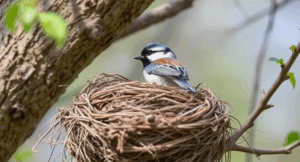
Can Birds Recognize Themselves in a Mirror?
Mirror Test: Assessing Self-Recognition in Birds

The mirror test is a widely used method to assess self-recognition in animals, including birds. It involves introducing a mirror into the bird’s environment and observing its response. If the bird recognizes its reflection as itself and not as another individual, it will display behaviors such as self-directed actions or attempts to interact with the mirror image.
Researchers have conducted numerous studies using the mirror test to explore the self-awareness of different bird species. Some birds, such as magpies and European jays, have demonstrated remarkable abilities to recognize themselves in mirrors. They have been observed engaging in self-exploratory behaviors, such as using the mirror to inspect hard-to-see parts of their bodies or deliberately altering their appearances. These findings highlight the cognitive sophistication of avian species and their capacity for self-recognition.
Mirror Neuron System: Understanding Avian Self-Awareness
The mirror neuron system is a crucial component in understanding avian self-awareness. These specialized neurons, first discovered in primates, are believed to play a role in imitative behavior and empathy. Recent research suggests that birds, too, possess mirror neurons, indicating the potential for self-recognition.
Studies conducted on birds, such as the European magpie and the kea parrot, have provided valuable insights into avian self-awareness and the mirror neuron system. In these experiments, birds were exposed to mirrors and observed their reactions. Interestingly, some birds exhibited behaviors that reflected self-recognition, such as preening or manipulating their feathers upon seeing their reflections. These findings indicate that avian species may possess a level of self-awareness similar to that of primates.
Exploring Avian Cognition: Mirror Self-Recognition in Birds
Mirror self-recognition is a fascinating area of study within avian cognition. While once believed to be exclusive to primates, recent research has revealed that certain bird species also possess the ability to recognize themselves in mirrors. This finding challenges previous assumptions about self-awareness in non-human animals and opens up new avenues for understanding avian cognition.
In order to explore mirror self-recognition in birds, researchers have employed various experimental methods. One commonly used approach involves placing a mirror in the bird’s enclosure and observing its behavioral responses. If the bird demonstrates self-recognition, it may engage in behaviors such as self-directed pecking or attempts to interact with its mirror image. By carefully analyzing these behaviors, researchers can gain insight into the cognitive processes underlying mirror self-recognition in birds.
The Science Behind Mirror Self-Recognition in Avian Species

Mirror self-recognition, a cognitive ability to recognize oneself in a mirror, has long been associated with higher intelligence in animals. While this ability has been extensively studied in primates and other mammalian species, researchers are now turning their attention to avian species. Birds, with their remarkable cognitive abilities and complex social behaviors, provide a unique opportunity to explore the science behind mirror self-recognition in a different taxonomic group.
Studies on mirror self-recognition in avian species have revealed intriguing findings. One of the key methods used to assess self-recognition in birds is the mirror test, where individuals are exposed to a mirror and their reactions are observed. Researchers look for signs of self-directed behaviors, such as exploring their own bodies or preening while looking at their reflection. While some avian species, such as magpies and pigeons, have demonstrated self-recognition, the extent and nature of this ability across different bird taxa is still a subject of investigation. Understanding the science behind mirror self-recognition in avian species can shed light on the cognitive capacities of birds and potentially provide insights into the evolution of self-awareness in animals.
Research Methods: Studying Avian Self-Awareness in Mirrors
As researchers delve into the fascinating realm of avian self-awareness, they are tasked with finding effective methods to study mirror self-recognition in birds. One primary research method involves presenting birds with mirrors and observing their behaviors and reactions. By carefully analyzing their interactions with their own reflections, scientists can gain valuable insights into the avian species’ ability to recognize themselves in mirrors.
In order to conduct these studies, researchers typically place mirrors within the birds’ habitats and allow them sufficient time to acclimate to their presence. This acclimation period ensures that the birds become familiar with the mirror and perceive it as a non-threatening entity. Following this, scientists closely monitor the birds’ reactions, looking for specific behaviors that indicate self-recognition. These behaviors can include self-directed actions, such as preening or posturing, as well as attempts to interact with or investigate their own reflection. Through these carefully designed research methods, scientists are able to better understand the extent of avian self-awareness and its underlying cognitive mechanisms.
Key Findings: Insights into Birds’ Ability to Recognize Themselves in Mirrors
Mirror self-recognition, once thought to be exclusive to humans and a select few species, has been found in a number of avian species. Recent research has shed light on the fascinating ability of birds to recognize themselves in mirrors. One key finding is that several bird species, including magpies, pigeons, and European jays, exhibit self-recognition when presented with a mirror. These birds display behaviors such as self-directed behavior, modified body postures, and attempts to remove marks on their bodies, indicating a level of self-awareness.
Another interesting insight is that the ability to recognize oneself in a mirror is not uniform across avian taxa. While some bird species readily engage in self-exploration behaviors in the presence of mirrors, others show little to no response. For example, it has been observed that certain songbirds, such as sparrows and canaries, show minimal interest in mirrors and do not seem to recognize their own reflection. These variations suggest that the capacity for mirror self-recognition may be influenced by factors such as social structure, ecological niche, and cognitive capabilities unique to each species. Further research is needed to explore the underlying reasons behind these species differences and their implications for avian cognition.
Species Variations: Examining Mirror Self-Recognition Across Avian Taxa

In the study of mirror self-recognition in avian species, researchers have discovered fascinating variations in the ability of different bird taxa to recognize themselves in mirrors. One species that has shown a strong capacity for mirror self-recognition is the European magpie (Pica pica). These intelligent birds have been observed engaging in self-exploration behaviors in front of mirrors, such as inspecting their bodies and manipulating their feathers. This suggests that magpies have a level of self-awareness, making them one of the few avian species known to possess this trait.
On the other hand, not all avian taxa have demonstrated the same level of mirror self-recognition. For instance, some studies have found that pigeons (Columba livia) are less likely to engage in self-exploration behaviors when confronted with a mirror. This indicates that pigeons may not possess the same level of self-awareness as magpies. These variations across avian taxa highlight the importance of understanding the underlying cognitive processes involved in mirror self-recognition and how they may differ among different bird species. Further research is needed to explore these species differences and unravel the complex mechanisms behind avian self-awareness.
Implications and Applications: Understanding the Significance of Avian Self-Recognition
Mirror self-recognition in birds holds great implications and applications in various fields of study. Firstly, it provides a window into avian cognition and intelligence. By demonstrating that birds possess self-awareness, researchers can delve deeper into understanding the cognitive abilities of these fascinating creatures. This knowledge can contribute to fields such as comparative psychology, animal behavior, and neuroscience, further expanding our understanding of the animal kingdom and its complexities.
Moreover, the significance of avian self-recognition extends beyond scientific research. Conservation efforts can benefit from this understanding, as it sheds light on the cognitive capacities of bird species. By recognizing individual birds’ ability to recognize themselves in mirrors, conservationists can better tailor conservation strategies to protect the well-being and habitats of these intelligent creatures. Understanding the significance of avian self-recognition can also facilitate bird training and behavioral enrichment programs, improving their welfare in captive environments. By tapping into this unique aspect of bird cognition, we can enhance their overall quality of life, ensuring a more holistic approach to their care and conservation.
Comparative Analysis: How Birds’ Mirror Self-Recognition Compares to Other Species
Mirror self-recognition is a phenomenon that has been extensively studied in various animal species. Among these species, birds have emerged as a fascinating subject of investigation. When comparing birds’ mirror self-recognition abilities to those of other species, several key differences become apparent.
One notable contrast is the variation in the onset and development of self-recognition. While certain primate species, such as chimpanzees and orangutans, demonstrate self-awareness at an early age, avian species appear to have a delayed acquisition of this skill. Birds typically require more time and experience to develop the ability to recognize themselves in a mirror. This discrepancy may be attributed to differences in brain structure and cognitive processes between birds and primates.
Future Directions: Unanswered Questions and Potential Areas of Research

As researchers continue to delve into the realm of avian self-awareness and mirror self-recognition, there are still numerous unanswered questions and exciting potential areas for future exploration. One key area of interest lies in understanding the underlying neural mechanisms that facilitate this ability in birds. While studies have shown that birds possess a unique mirror neuron system similar to mammals, the exact functioning and connectivity of these neurons remain largely unexplored. Investigating the neural basis of avian self-recognition has the potential to unveil fascinating insights into the evolutionary origins of self-awareness and the cognitive abilities of avian species.
Additionally, there is a need to investigate the specific factors that influence mirror self-recognition in different avian taxa. Currently, research has predominantly focused on species that display clear signs of self-recognition, such as pigeons and magpies. However, there is a wide range of avian species that have not yet been subjected to thorough mirror self-recognition tests. Exploring the potential variability across avian taxa could provide valuable information about the factors that contribute to the development of self-awareness in birds. Comparative studies between different bird species and other self-recognition-capable animals could help identify unique evolutionary trajectories and shed light on the broader understanding of self-awareness in the animal kingdom.


